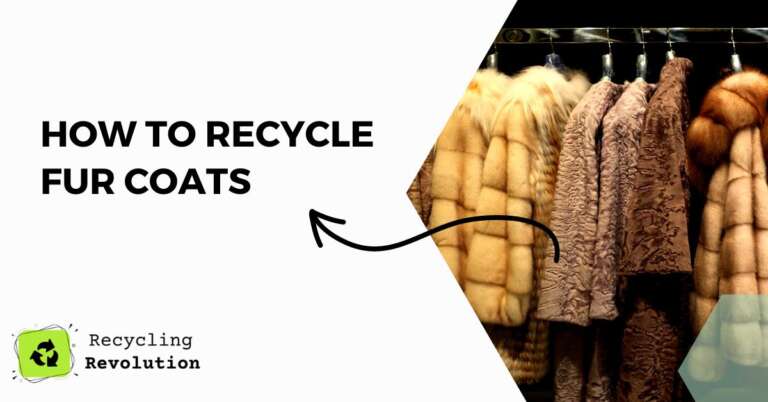Fur coats. To some, they’re a statement of luxury. To others, they’re a testament to bygone times. But one thing’s for sure – in the current environmentally conscious age, most of us are aiming to reduce waste and be more sustainable.
The question thus arises, how can we responsibly recycle fur coats?
tl;dr: Recycling fur coats primarily involves repurposing or donating them. You can turn them into new items, donate to organizations, or offer them to specialized recycling facilities. Always ensure to clean and store them properly before recycling.
The Sustainability Quandary
It’s worth noting why the topic of recycling fur coats is even on the table. Fur, as a natural product, can decompose. However, due to the chemicals used in its preservation, a fur coat in a landfill can take many years to break down, leading to a longer environmental impact.
Why Not Just Throw it Out?
I recommend resisting the temptation to merely discard old fur coats. While it’s tempting to dispose of items we no longer need, remember: every fur coat thrown into a landfill represents not just a waste of resources, but also a missed opportunity for recycling or repurposing.
Repurpose: Giving Fur a Second Life
One of the best ways to recycle fur is to repurpose it. This means transforming the coat into another wearable or usable item.
Fur Accessories
Think of fur hats, mittens, scarves, or even boot linings. A single coat can provide material for several of these items. I recommend seeking out local tailors or artisans who specialize in fur products for this transformation.
Home Decor
Old fur coats can become plush pillows, throw blankets, or even rugs. Imagine the softness and warmth of fur in your living space without the guilt of buying a brand-new fur item.
Donations: Spread the Warmth
If you don’t see yourself using repurposed fur, consider donating it. There are numerous organizations that will gladly accept fur donations.
Coats for the Homeless
Some charities specifically collect fur coats to provide warmth for homeless individuals during harsh winter months. It’s a humane way to extend the life and utility of a fur coat.
Theater and Schools
Local theater groups or school drama departments often need costumes for their productions. A fur coat can be a priceless donation for them, serving many performances over the years.
Specialized Fur Recycling
If repurposing or donating doesn’t resonate with you, there are specialized facilities that can take your fur and ensure it’s recycled in an eco-friendly manner.
Breaking Down the Fur
Some facilities are capable of breaking down fur to its natural state, allowing it to be used in other textile products or even as organic compost. These methods are less common, but with the rise in sustainable practices, their prevalence is likely to increase.
Note: Before choosing this option, always research the facility to ensure they are genuinely sustainable and not just disposing of the fur in landfills.
Care Before Recycling
Regardless of your chosen recycling method, it’s crucial to ensure the fur is clean and well-stored.
Proper Storage
I recommend keeping fur in a cool, dry place away from direct sunlight. This prevents the fur from becoming brittle or discolored, ensuring it remains in good condition for its next life.
Cleaning
Before recycling, make sure your fur is clean. You can consult with a fur specialist or look for eco-friendly cleaning methods that won’t harm the texture or quality of the fur.
The Ethics of Fur: An Important Consideration
While discussing the recycling of fur coats, it’s paramount to touch upon the ethics of fur. The fur industry has long been the subject of scrutiny due to animal rights concerns. This ethical lens should always be considered, especially if you’re thinking of purchasing fur in the future. By recycling, repurposing, or donating your fur coats, you can reduce the demand for new fur products.
A Circular Economy Approach
The concept of a circular economy is to keep products in use for as long as possible, extract the maximum value from them while in use, and then recover and regenerate products and materials at the end of their life. Fur coats, with their durability and longevity, fit well into this model.
I recommend always thinking of the bigger picture. When you recycle fur, you’re not just making a one-time choice but promoting a cycle of sustainability.
Fur Rehabilitation: Repair and Restore
Before diving into recycling options, evaluate if your fur coat can be rehabilitated. Just like you’d repair a torn piece of clothing, fur can often be restored to its former glory.
Find a Furrier
A furrier is an artisan skilled in handling, crafting, and repairing fur. If your coat is looking a little worse for wear, a visit to a reputable furrier can breathe new life into it. Mending tears, replacing worn-out linings, or even restyling an old-fashioned silhouette can make your fur coat feel brand new.
Note: Always seek out furriers with good reviews and ethical practices.
Fur Swapping: A Sustainable Exchange
In some communities, fur swapping events have emerged as a popular and sustainable way to give fur items a new lease on life. These events operate on a simple principle: you bring a fur item you no longer want and exchange it for something you’d like to wear or use.
Benefits of Swapping:
- Reduce Consumerism: By swapping instead of buying new, you reduce the demand for fresh resources.
- Community Building: Swapping events are not only about exchanging items but also about connecting with like-minded individuals.
- Diverse Choices: These events can offer a range of styles, ensuring that participants have a broad array of choices.
The Beauty of Craftsmanship: DIY Fur Projects
If you’re the crafty type, there’s a world of DIY projects awaiting your old fur coat. From smaller items like bookmarks or jewelry to bigger projects like vests or handbags, there’s no end to the creative possibilities.
Steps to DIY with Fur:
- Planning: Decide on a project that suits your skills and the amount of fur you have.
- Gathering Tools: Ensure you have the right tools. Specialized needles, threads, and other tools might be required.
- Execution: Follow DIY tutorials or create based on your vision. Always remember to handle fur gently to maintain its quality.
Note: If you’re new to working with fur, I recommend starting with smaller projects to get the hang of it.
The Environmental Impact: A Deeper Dive
It’s essential to understand the environmental footprint of fur. Unlike synthetic alternatives, fur is biodegradable. However, the process to make it long-lasting and wearable often involves chemicals that reduce its biodegradability.
I recommend always weighing the environmental pros and cons. While fur can last for decades, reducing its frequent purchase and promoting its recycling can help offset its environmental impact.
The Legacy Aspect: Passing Down Fur
Fur coats, especially those of high quality, can become family heirlooms passed down through generations. Before considering recycling options, ponder whether your fur coat has sentimental value that might be cherished by future generations.
By storing fur correctly and ensuring its regular maintenance, it can be preserved for decades, making it a cherished item for your descendants.
Conclusion
Recycling fur coats is not just about disposing of an old item; it’s a conscious decision to be sustainable and responsible. Whether it’s through repurposing, donating, or seeking specialized recycling, every fur coat saved from the landfill is a win for the environment.
FAQ:
Can fur be composted?
While fur is organic and can decompose, the chemicals used in preserving fur coats make it less suitable for composting unless broken down in specialized facilities.
Are there any charities that won’t accept fur?
Yes, some charities, particularly those with ethical concerns about fur, may decline fur donations. Always check with an organization first before donating.
How can I find specialized fur recycling facilities?
A quick online search or consultation with local sustainability organizations can guide you to reputable fur recycling facilities.
Remember, every step towards sustainability counts, and recycling that old fur coat is a step in the right direction!

